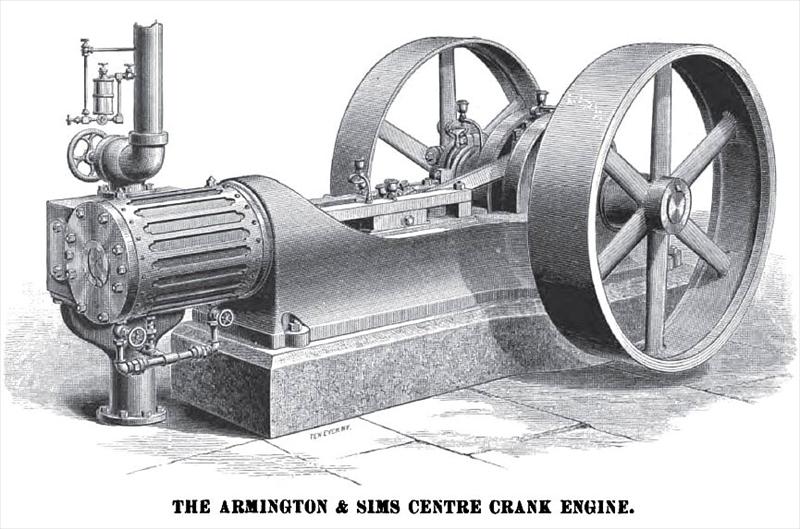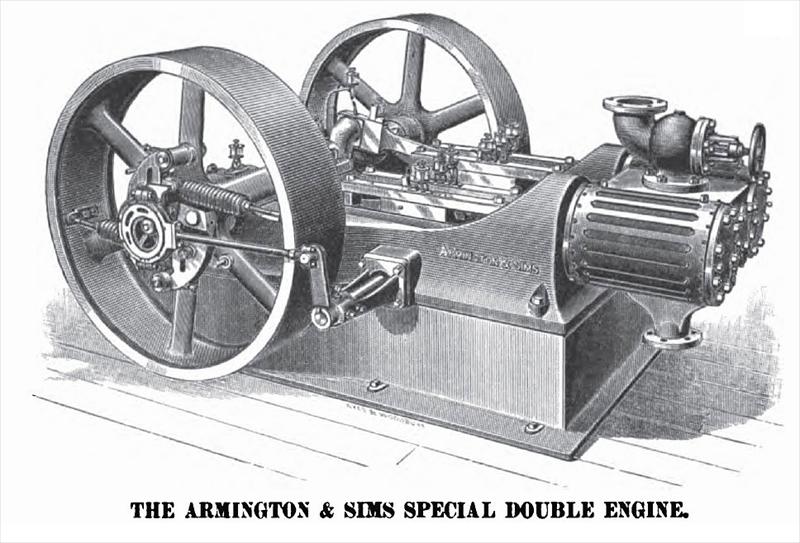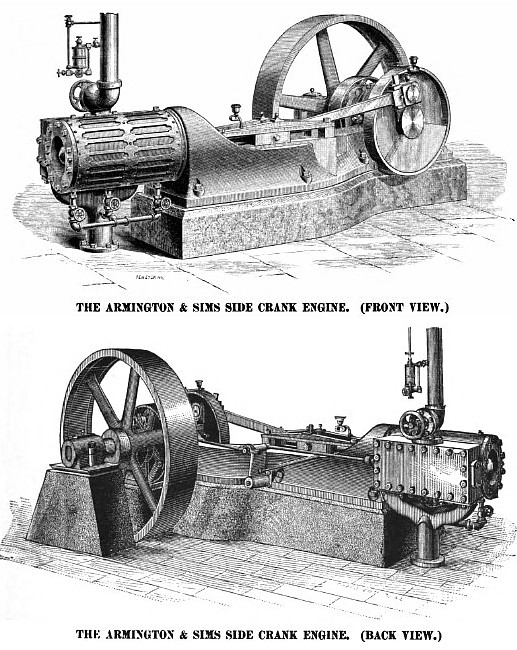|
Title: |
1890 Article-Armington & Sims Co., Steam Engines |
|
Source: |
The Steam User 1890 pgs 84-87 |
|
Insert Date: |
4/19/2011 9:33:29 PM |
The Armington & Sims Engines, of which illustrations are shown on the opposite and on the page following, are built in several styles, to meet the various requirements of speed and power. The bed of these engines is of the well known Porter-Allen type, made very heavy, having interior longitudinal and cross ribs, thus ensuring the utmost attainable stiffness; the front cylinder head is independent of the bed, to which it is attached by studs fastened from the inside, thus easily allowing repairs to be made; the slide-bars have large surfaces, accurately scraped; the connecting-rod is of most approved form, and allowance is made for taking up wear of boxes; the main bearing is very large, and has adjustable cheek pieces; the disk of sufficient size to allow of the perfect balancing of the reciprocating parts; the crankpin is of steel, accurately ground, and of such size as to prevent heating; the shaft is of ample size to prevent springing, and is accurately ground at the bearings.
The steam-chest, with valve seat, is in one casting with the cylinder; the valve-chest is enclosed by a cover in the usual manner; this is a very desirable feature, as it enables the boring for valve and squaring up the ports to be accurately done, and it also gives an opportunity for the engineer to easily set the valve should it be necessary.
The governor used is of the latest and most approved form, and an idea of the close regulation it gives can be seen from the following report of a test made some years ago at the station of the Brush Electric Lighting Company, Boston.
This company have found it necessary to add to their steam-power, and a dynamo machine for day circuit, and for this purpose they chose an Armington & Sims engine, 9 1/2 inches in diameter, and 12 inches stroke, which has been put upon the second floor of the building which they occupy, and bolted down on a couple of hard-pine timbers, turned upon edge on the floor, which is not particularly calculated for that class of machinery. This engine is now making 310 revolutions per minute, running thirteen hours per day without stopping. A No. 8 Brush light machine, carrying forty lights, is driven by a belt directly from the balance-wheel pulley upon one side of the engine, and a No. 7 Brush machine is now to be placed upon the other side, or to be belted from the pulley upon the opposite side of the machine, carrying six lights, making fifty-six lights in all. Last week some parties wished to try an experiment with the engine, and a dynamo machine No. 8, running 710 revolutions per minute, feeding forty-one lights, with the engine at full speed; the wire was instantly disconnected (without slowing the engine) by removing it from the pole on the bed of the machine. No variation was discernible in the speed of the engine. After waiting for five minutes, the wire was put back into the post and secured as suddenly as it could be, when all the lamps lighted again, without showing any variation in the speed of the engine.
This is a very unusual test—to throw off or throw on the full load under which an engine of that size and speed is working—and those parties, among whom were engine-builders and engineers, that witnessed the experiment were simply astonished at what they saw.
Armington & Sims build several other styles of engines, among which is their Special Double Compound. One of the desirable features as compared with engines of the single-acting type is the small space required. Being double-acting (that is, taking steam from both sides of the piston), it requires but one-half the piston area for same
power, and although the connecting-rods are all made 6 to 1, yet the floor space does not greatly exceed the upright single-acting type; for example—this 100-H.-P. engine has cylinders 9 1/2 inches diameter x 10 inches stroke, a single-acting engine running at same velocity and piston speed to give same power would require two cylinders each 13 1/2 inches diameter, and the length of engine, including wheels, must be considerably more than the width of this style. Of course in height there is all the advantage.
The governor used on this style of engine, which is built up to 250 horse-power, is the same as is used on their standard engines. The valve, which is an important factor in the economy of the Armington & Sims engine, is perfectly balanced, and surrounded at all times by live steam. By its unique construction it permits the full boiler pressure to be maintained in the cylinder up to the point of cut-off.
An improved cylinder oiler is furnished with each engine, which allows the oil to be fed a drop at a time through a glass tube, as needed to lubricate the starting valve, engine valve, and piston. The slide bars and main bearings have oil cups of improved form, allowing the oil to be fed in proper quantity, always in sight of the engineer. The device for oiling the crank and wrist pins is simple and effective. The cup is mounted on a bracket, and delivers its supply of oil a drop at a time, which is caught by a blade in the oil cup attached to the connecting-rod. A somewhat similar device is arranged for the eccentric strap.
The arrangements for oiling have been so carefully attended to that these engines can be run for days without stopping, and in fact are so running in a number of paper mills, for driving Fourdrinier machines, where a uniform, constant speed is required continuously for a week at a time.
This company also build triple expansion engines having four cylinders, in sizes up to 500 horse-power.
(These engines are built by the Armington & Sims Engine Company, Providence, R. I.) |
|
 1890 Armington & Sims Co., Centre Crank Steam Engine
1890 Armington & Sims Co., Centre Crank Steam Engine
 1890 Armington & Sims Co., Special Double Steam Engine
1890 Armington & Sims Co., Special Double Steam Engine
 1890 Armington & Sims Co., Side Crank Steam Engine
1890 Armington & Sims Co., Side Crank Steam Engine
|
|